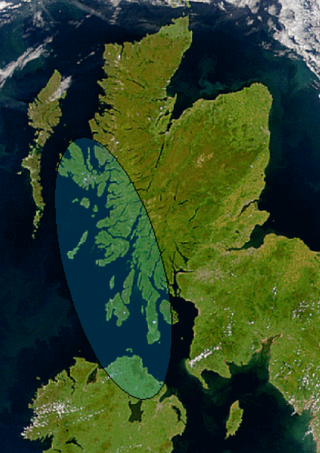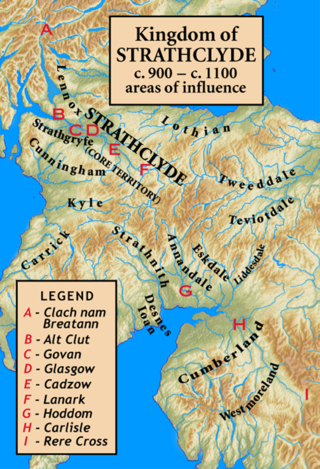
Dál Riata or Dál Riada was a Gaelic kingdom that encompassed the western seaboard of Scotland and north-eastern Ireland, on each side of the North Channel. At its height in the 6th and 7th centuries, it covered what is now Argyll in Scotland and part of County Antrim in Northern Ireland. After a period of expansion, Dál Riata eventually became associated with the Gaelic Kingdom of Alba.

Strathclyde was a Brittonic kingdom in northern Britain during the Middle Ages. It comprised parts of what is now southern Scotland and North West England, a region the Welsh referred to as Yr Hen Ogledd. At its greatest extent in the 10th century, it stretched from Loch Lomond to the River Eamont at Penrith. Strathclyde seems to have been annexed by the Goidelic-speaking Kingdom of Alba in the 11th century, becoming part of the emerging Kingdom of Scotland.
Alpín mac Echdach was a supposed king of Dál Riata, an ancient kingdom that included parts of Ireland and Scotland.
Eochaid mac Domangairt was a king of Dál Riata in about 697. He was a member of the Cenél nGabráin, the son of Domangart mac Domnaill and father of Eochaid mac Echdach; Alpín mac Echdach may be a son of this younger Eochaid.

Áedán mac Gabráin, also written as Aedan, was a king of Dál Riata from c. 574 until c. 609 AD. The kingdom of Dál Riata was situated in modern Argyll and Bute, Scotland, and parts of County Antrim, Ireland. Genealogies record that Áedán was a son of Gabrán mac Domangairt.
Fergus Mór mac Eirc was a possible king of Dál Riata. He was the son of Erc of Dalriada.

Ulaid or Ulaidh was a Gaelic over-kingdom in north-eastern Ireland during the Middle Ages made up of a confederation of dynastic groups. Alternative names include Ulidia, which is the Latin form of Ulaid, and in Cóiced, Irish for "the Fifth". The king of Ulaid was called the rí Ulad or rí in Chóicid.
Eochu or Eochaid Feidlech, was a High King of Ireland, according to medieval Irish legends and historical traditions. He is best known as the father of the legendary queen Medb of Connacht.
Lugaid is a popular medieval Irish name, thought to be derived from the god Lug. It is borne by a number of figures from Irish history and mythology, including:
Ailill is a male name in Old Irish. It is a prominent name in Irish mythology, as for Ailill mac Máta, King of Connacht and husband of Queen Medb, on whom Shakespeare based the Fairy Queen Mab. Ailill was a popular given name in medieval Ireland, meaning something like "beauty".
Erc was king of Irish Dál Riata from 439 until 474, succeeding Eochaid Muinremuir. He was the father of three sons: Fergus Mór, Loarn and Oengus. He also may have been the great-grandfather of Muirchertach mac Muiredaig. Confusion arises from the latter's matronym, Macc Ercae, said to come from his legendary mother Erc ingen Loarn, daughter of Loarn mac Eirc. She married Muiredach mac Eógain. According to the Duan Albanach and the Senchus Fer n-Alban, Erc of Dál Riata's father was Eochaid Muinremuir, son of Áengus Fert, son of Fedlimid, son of Oengus, son of another Fedlimid, son of Senchormaich, son of Cruitlinde, son of Findfece, son of Archircir, son of Eochaid Antoit, son of Fiacha Cathmail, son of Cairbre Riata, son of Conaire Cóem and Saraid ingen Chuinn.

Dál nAraidi or Dál Araide, sometimes latinised as Dalaradia or anglicised as Dalaray, was a Cruthin kingdom, or possibly a confederation of Cruthin tribes, in north-eastern Ireland during the Middle Ages. It was part of the over-kingdom of Ulaid, and its kings often contended with the Dál Fiatach for the over-kingship of the province. At its greatest extent, the borders of Dál nAraidi roughly matched those of County Antrim, and they seemed to occupy the same area as the earlier Robogdii of Ptolemy's Geography, a region shared with Dál Riata. Their capital was Ráth Mór outside Antrim, and their eponymous ancestor is claimed as being Fiachu Araide.
Fíachnae mac Báetáin, also called Fíachnae Lurgan or Fíachnae Find, was king of the Dál nAraidi and High King of the Ulaid in the early 7th century. He was a son of Báetán mac Echdach and brother of Fiachra Cáech, grandson of the Ulaid king Eochaid mac Condlai and father of Mongán mac Fiachnai.

Dál Fiatach was a Gaelic dynastic-grouping and the name of their territory in the north-east of Ireland, which lasted throughout the Middle Ages until their demise in the 13th century at the hands of Normans. It was part of the over-kingdom of Ulaid, and they were its main ruling dynasty for most of Ulaid's history. Their territory lay in eastern County Down. Their capital was Dún Lethglaise (Downpatrick) and from the 9th century their main religious site was Bangor Abbey.
Crimthann, Cremthann or in Modern Irish Criofan, is a masculine Irish given name meaning fox. Notable people with the name include:
Fergus or Feargus is a common and one of the oldest known Scottish or Irish male given name derived from Old Irish, meaning "the strong (one)" or "the masculine (one)".
Mongán mac Fíachnai was an Irish prince of the Cruthin, a son of Fíachnae mac Báetáin. Little is certainly known of Mongán's life as only his death is recorded in the Irish annals. He appears as a character in the Cycles of the Kings where he is said to have been the son of Manannán mac Lir and perhaps a reincarnation of the legendary hero Finn mac Cumaill of the Fenian Cycle.
Muiredach, Muireadhach or Muireach, anglicized variously to Murdoch, Murtagh, Murray, Murdac, Mordacq and other forms, is a Goidelic name popular in Scotland and Ireland in the Middle Ages:



